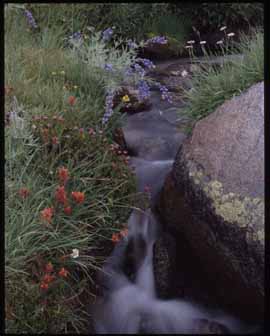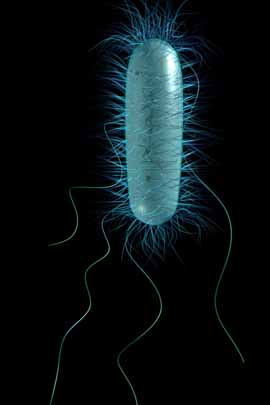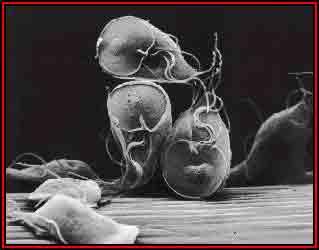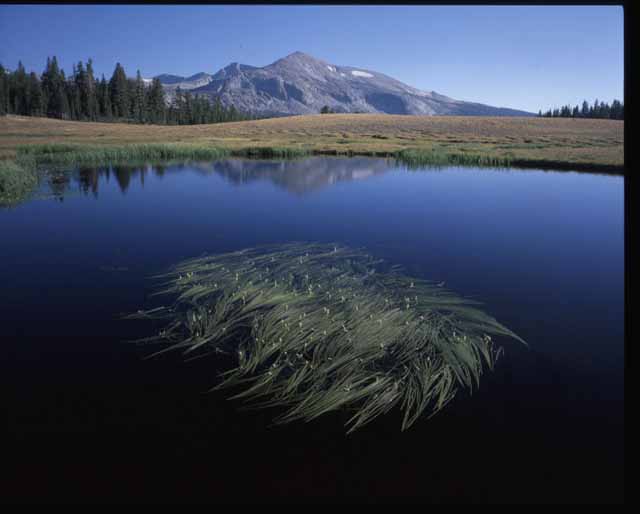Sierra
Nature Notes, Volume 3, April 2004
High Sierra Water: What is in the H20?
Robert W. Derlet, MD
Professor of Medicine
School of Medicine
U.C. Davis
Kemal Ger
Department of Environmental Science
University of California, Davis
 |
| At the
heart of the Sierra experience: A pristine stream. Photo © Howard Weamer |
Introduction
I have backpacked throughout the Sierra for over 30 years and
delight at the pristine beauty of this unique mountain range. From the tiny
creeks,
to the
largest streams, and the crystal clear bright blue lakes, the freshwater
in the Sierra helps to provide the most pristine settings in the world. Although
the water has always appeared clean, I became concerned in the 1980s with
the
public alerts about Giardia contamination, and becoming ill with Giardiasis.
Four years ago, I decided to utilize my knowledge of infectious diseases, microbiology, and ecology to study the lakes and streams throughout the Sierra. Some of the questions I wanted answers to included: Is the water fit to drink without filtering or adding iodine tablets? What actually is in the water? After hiking nearly 1,600 miles over these past four years I have learned much about water and more about the Sierra. In addition, I worked in collaboration with Kemal Ger and other scientists in the Department of Environmental Science at UC Davis to further our understanding of water ecology in the Sierra. The water contains many things from inorganic matter to organic particles to many forms of life.
Water: Basic Composition
Suspended and dissolved within the H20 in the Sierra are many nutrients necessary
for the ecological balance of the Sierra. These nutrients are important to
support growth from the smallest water organisms, the bacteria, to the rainbow
trout species that populate the waterways, and are present even though the
water appears crystal clear.
The growth of all living organisms may be limited by absence or low amounts of critical elements. Most importantly, their concentration in water determines the growth and density of algae. Main nutrients in limited quantities include forms of phosphorus, nitrogen, iron, zinc, molybdenum and cobalt. Phosphorus (P) is typically bound to sediments and enters the water through terrestrial sources like erosion, while nitrogen (N) can enter through runoff and atmospheric deposition. N and P are cycled throughout the ecosystem from microbes making it available to plants and animals, and vice versa. Nitrogen limitation is typical for western mountain lakes; however, nitrites are generally not the rate-limiting factor in Central and Southern Sierra water because of the nitrous oxides which blow in from the Central Valley of California. In most cases, phosphates are the great limiting factor for the growth of living organisms. Specialists in inland water science, called limnologists, have terms for lakes and streams that have limited chemical nutriments. The word oligotrophic means rate limiting amounts of chemicals exist for growth limit the growth rate of algae and other organisms. Eutrophification is a term to describe nutriment loading which leads to excessive growth of algae in other living organisms. Lake Tahoe is an example of a Sierra lake threatened by eutrophification. The crystal clear waters of Lake Tahoe have been sustained by extensive work from scientists such as Charles Goldman, Ph.D., of UC Davis, in order to limit eutrophification. Some measures include pumping of sewage sludge out of Lake Tahoe, preventing the use of salts, nitrates, and phosphorus on roadways, and limiting other pollutants going into the lake.
In addition to chemical nutriments, dirt, sediment, decaying leaves, pine needles, and twigs are also important to sustain a balanced ecosystem in the Sierra. These nutriments have carbon, which is essential for any type of life from bacteria up through fish. In the high Sierra backcountry, ingestion of the basic nutriment supply in water is safe.
Viruses
Viruses generally do not do well in the open, exposed, harsh environment of
the Sierra. Although certain viruses such as Norwalk Virus (Cruise Ship Virus)
have the ability to sustain viability on external surfaces, survival in the
Sierra landscape would be very difficult. Furthermore, no documented cases
of viral acquired illnesses can be traced from drinking water from Sierra
streams or lakes. Purification to kill viruses in most backcountry acres
of the Sierra is not necessary.
Bacteria
Bacteria have the ability to survive and actually thrive within Sierra lakes
and streams. On average 10,000 bacteria swim in each quart of water in the
Sierra. These normal aquatic bacteria are not harmful to humans and actually
serve an important nitch in the ecological chain. They may fix nitrogen to
be utilized in higher forms of life and are also ingested by Sierra zooplankton.
Only rarely do bacteria originate from animals and result in contamination
of lakes and streams. For example, bird droppings may fall in a lake and
contaminate lakes with a species of bacteria called Yersinia. However, the
vast majority of Yersinia species are not harmful to humans.
 |
| Computer
generated model of Escherichia coli. © 1998 American Museum of Natural History. All Rights Reserved. |
E-coli: The finding of E-coli and other coliform bacteria suggests fecal contamination into waterways. This may occur from native animals, birds, cows, sheep, pack animals, or humans. We have found very low levels of E-coli in some water samples throughout the Sierra. In many places where E-coli has been found, there has been no human or pack animal activity implying that the E-coli are either part of the natural environment or as a result of contamination from animals. One of our most consistent findings has been the presence of E-coli below meadows in which cattle have grazed. Indeed, E-coli can be found even two years after the last cattle have grazed, suggesting long-term viability in the environment. Long-term stability of E-coli in the environment has been described elsewhere.
In most areas of Kings Canyon National Park we have not found any correlation between human use and the presence of E-coli. For example, at lower Bubbs Creek, just before the confluence of the Middle Fork of the Kings River, we have not found any E-coli after several samplings throughout two seasons. Similarly, E-coli has not been found at the Middle Fork of the Kings River just above the confluence of Bubbs Creek dispite being below heavily used Paradise Valley. Rae Lakes have been free from E-coli or other coliforms during our analysis.
Paradoxically, water downstream from some of the sample sites yielding E-coli may be free of the organisms. This may be secondary to dilutional effects, filtration by flowing underground, or the effects of sunlight, which is known to have some effect in killing bacteria. In very rare instances, the E-coli has been found below areas heavily used by backpackers in parts of the Sierra. Should you treat your water to kill bacteria? This is a personal decision, and depends on the risk the individual wishes to take. I believe the risk is low and treat my water in only two situations: 1) below cow and sheep pastures; and 2) in slow flowing, warm streams immediately below places humans may be swimming or bathing. We have found total bacterial levels to be lower in lakes than streams. This may be due to settling effects, or ingestion of bacteria by zooplankton or other small organisms.
 |
| Giardia
lamblia trophozoites as they appear with
the scanning electron microscope. Original image: Arturo Gonzalez, CINVESTAV, Mexico |
Giardia
In the 1980s backpacker literature was filled with the dangers of Giardia
in the Sierra. I, along with other scientists believe that the risk of Giardia
has been well overstated. Yes, there are “hot spots” of Giardia
of which there is risk of acquisition. Giardia is a zoonotic-type infection
with host in many non-human mammals. We have analyzed multiple specimens
of pack animal manure along the John Muir Trail and have not found significant
amounts of Giardia. Furthermore, other studies examining horse and pack animal
manure of animals using back country trails has failed to yield significant
amounts of Giardia. Of concern also is the long survivability of Giardia
in cold climates. If one wants to be entirely safe, one could purify water
but my suspicion is that perhaps less than 1% of streams in the Sierra would
have Giardia significant enough to cause infection in humans.
Plankton and Algae
Plankton refers to organisms in the water that are suspended and cannot swim.
Plankton includes algae (phytoplankton), zooplankton, and microbes. Zooplankton
are tiny animals that feed on microbes and algae. Zooplankton are the main
food source for young fish, and are important indicators of how much and
what types of algae is found in a lake. Zooplankton may actually serve to
reduce the risk of pathogenic bacteria in the Sierra because the zooplankton
feed on bacteria.
Algae refer to aquatic plants that lack roots and a vascular system, and use chlorophyll a as the main photosynthetic pigment. There are several types of algae, also referred to as phytoplankton – plant plankton. Depending on the nutrient dynamics of a lake and its surrounding watershed, lakes can have lots of algal growth and biomass, producing a green, murky water, full of algae. Algae can also be in the benthic form, attached to the bottom. Extreme abundance of algae in the water and bottom of the lake is an indicator of eutrophication (excess nutrients). In the mountain lakes of the Sierra, lakes are naturally nutrient limited, giving the clear deep blue oligotrophic lakes. In such lakes, there is little algal biomass, and the ecosystem is based on this condition. However, nutrient loading, primarily with phosphorous runoff, can lead to excessive overgrowth of algae, not only destroying the pristine beauty of Sierra lakes, but also depleting oxygen and placing fish at risk.
Although algae produce oxygen by photosynthesis, excessive growth reduces light reaching the bottom layers of the lake, causing reduced photosynthesis in the deeper layers. More importantly, microbes decompose the excess algal growth, which eventually sinks to the bottom of the lake. Decomposition uses all the oxygen in the water and the lakes become partially or entirely anoxic. This condition of no oxygen radically alters the ecosystem, killing fish and other animals that all rely on oxygen.
The vast majority of lakes and streams in the high Sierra do not have a major problem with algae. However, we do have a concern with use of soaps and other phosphate containing chemicals that may be introduced by backpackers. A decrease in the clarity of lakes, implying overgrowth of algae, has been noted by us in some Sierra lakes below areas heavily used by backpackers. This eutrophication is usually easy to identify. Water clarity and the types of algae present say a lot about the nutrient regime. Cyanobacteria and other forms of algae that are less food quality for zooplankton are typical of high nutrient systems.
Water clarity is affected by number of suspended sediments and amount of algal biomass. Most of the high Sierra lakes are clear (oligotrophic) water lakes, in which we know there is very little sediment runoff and low nutrients. Water clarity is an excellent indicator for increased algal growth. Both sediment inflow, as well as algal growth can be assessed by looking at changes in the water clarity. Greening of lakes typically implied increasing algal growth due to increased nutrient loading. Phosphates arrive in lakes through sediment runoff (from roads and trails), feces of wildlife, and the use of soaps, etc. Thus, greening lakes should be an alert for changing lake conditions and nutrient loads. It is much easier to control the amount of nutrients entering a lake at the onset of eutrophication compared to a lake that has been eutrophic for a while. Once there are excessive levels of nutrients in lakes it is difficult to revert back to an oligotrophic state.
 |
| Maintaining
pure Sierra water is an individual responsibility: Dana Meadows, Yosemite
National Park. Photo © Howard Weamer |
Conclusions
The Sierra Nevada backcountry lakes and streams, by and large, are pristine
and clear. In part this is due to the heavy snowmelt runoff each spring, which
washes out potential pollutants. In addition, it is from the hard work from
the National Park Service and National Forest Service Backcountry Rangers
in order to limit contamination of the backcountry area by visitors. However,
threats exist from Central Valley air pollutants dissolving in the water
and the remaining tracts where cattle or sheep graze. Finally, some human
visitors, who disregard the rules of etiquette and regulations for preserving
this national treasure, are also a threat.
Further Reading
An Analysis of Human Pathogens Found in Horse/Mule Manure Along the John
Muir Trail in Kings Canyon and Sequoia and Yosemite National Parks
Robert Wayne Derlet, MD; James Reynolds Carlson, PhD
Giardia Lamblia and Giardiasis:
With Particular Attention to the Sierra Nevada
by Robert L. Rockwell, PhD
Minimum Impact Regulations for backcountry use (National Park Service, Sequoia and Kings Canyon National Parks)
Our Founder Questions? Go to About Our New Site |
Masthead
Photo from: |